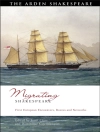Shakespeare’s plays are fascinated by the problems of speed and flight. They are repeatedly interested in humans, spirits, and objects that move very fast; become airborne; and in some cases even travel into space. In Speed and Flight in Shakespeare, the first study of any kind on the subject, Steggle looks at how Shakespeare’s language explores ideas of speed and flight, and what theatrical resources his plays use to represent these states. Shakespeare has, this book argues, an aesthetic of speed and flight. Featuring chapters on The Comedy of Errors, A Midsummer Night’s Dream, Romeo and Juliet, Henry V, Macbeth and The Tempest, this study opens up a new field around the ‘historical phenomenology’ of early modern speed.
Table des matières
Chapter 1: Introduction.- Chapter 2: Acceleration in
The Comedy of Errors.- Chapter 3: Taking Flight in
Romeo and Juliet.- Chapter 4: The Speed Demons of
A Midsummer Night’s Dream.- Chapter 5: The Action of the Tiger:
Richard III and Henry V.- Chapter 6:
Macbeth: Life in Fast Forward.- Chapter 7: Free Flight:
The Tempest.- Chapter 8: Conclusion.
A propos de l’auteur
Matthew Steggle is Professor of English at the University of Bristol, UK. His research interests include early modern literature and drama, with a particular focus on ’historicized performance studies’, and ‘acoustic approaches’ to early modern drama. His publications include four monographs on early modern drama; editions of plays by Shakespeare, Jonson, and Brome; and dozens of scholarly articles and book chapters. Steggle is also Co-editor of the AHRC-funded Oxford Works of John Marston project, and of the Lost Plays Database.












